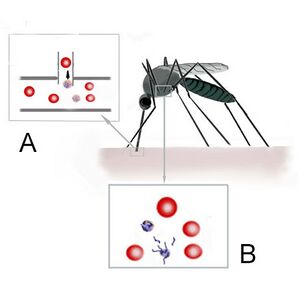Re-infection of the mosquito: Difference between revisions
From haematologyetc.co.uk
No edit summary |
No edit summary |
||
| Line 9: | Line 9: | ||
{| class="wikitable" style="border-style: solid; border-width: 5px; border-color: #023020; color:black" | {| class="wikitable" style="border-style: solid; border-width: 5px; border-color: #023020; color:black" | ||
|colspan="1" style = "font-size:100%; color:black; background: #afbddb |''' | |colspan="1" style = "font-size:100%; color:black; background: #afbddb |'''Gametogenesis and sexual replication''' | ||
|} | |} | ||
<gallery mode="nolines" widths=300px heights=300px> | <gallery mode="nolines" widths=300px heights=300px> | ||
File:Mosquito uptake.jpg|<span style="font-size:90%">'' | File:Mosquito uptake.jpg|<span style="font-size:90%">''Development within the the mosquito''</span>|link={{filepath:Mosquito uptake.jpg}} | ||
</gallery> | </gallery> | ||
When a mosquito feeds from a malaria infected hosts, the blood meal will contain parasites of all formas, but importantly including male and female gametocytes. The pH and temperature changes with the mosquito stomach cause the gametocytes to gain full sexual maturity ( | When a mosquito feeds from a malaria infected hosts, the blood meal will contain parasites of all formas, but importantly including male and female gametocytes. The pH and temperature changes with the mosquito stomach cause the gametocytes to gain full sexual maturity (gametogenesis). The male gametocyte then undergoes 3 cycles of division to generate 8 male sexual forms (gametes). These then 8 gamaetes then "break out" of the male microgametocytes in a process known as exflagellation, and fuse with the female gamete (derived from the macrogametocyte) then following successful fusion move to the next stage of development with the mosquito gut wall. Finally the parasite enter the salivary glands of the mosquito as sporozoites where a new infection can be initiated. | ||
---- | ---- | ||
[[Storage changes in malaria]] | |||
{| class="wikitable" style="border-style: solid; border-width: 5px; border-color: #023020; color:black" | |||
|colspan="1" style = "font-size:100%; color:black; background: #afbddb |'''Relevance to blood''' | |||
|} | |||
[[Storage changes in malaria|clinical film appearance]] | |||
Revision as of 13:09, 29 April 2024
Navigation
(click blue highlighted text to return to page)
Malaria main index
>Basic malaria biology
>>This page: Re-infection of the mosquito
| Gametogenesis and sexual replication |
When a mosquito feeds from a malaria infected hosts, the blood meal will contain parasites of all formas, but importantly including male and female gametocytes. The pH and temperature changes with the mosquito stomach cause the gametocytes to gain full sexual maturity (gametogenesis). The male gametocyte then undergoes 3 cycles of division to generate 8 male sexual forms (gametes). These then 8 gamaetes then "break out" of the male microgametocytes in a process known as exflagellation, and fuse with the female gamete (derived from the macrogametocyte) then following successful fusion move to the next stage of development with the mosquito gut wall. Finally the parasite enter the salivary glands of the mosquito as sporozoites where a new infection can be initiated.
| Relevance to blood |
